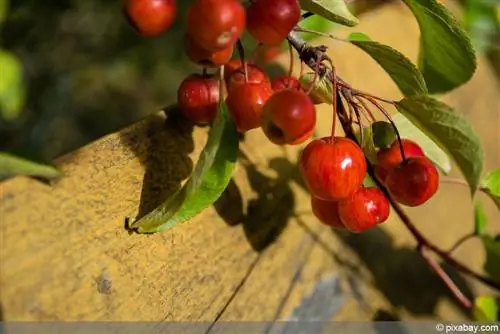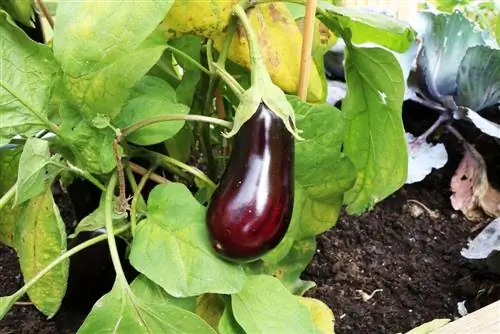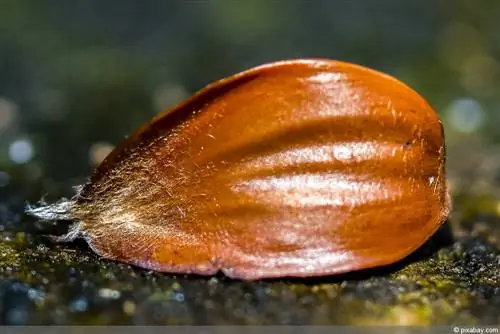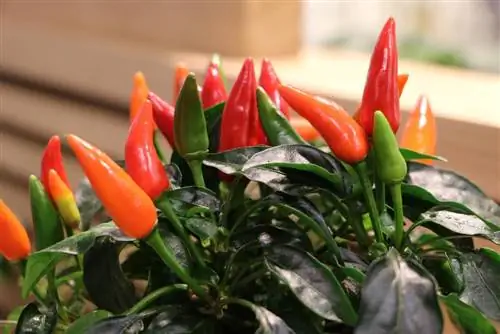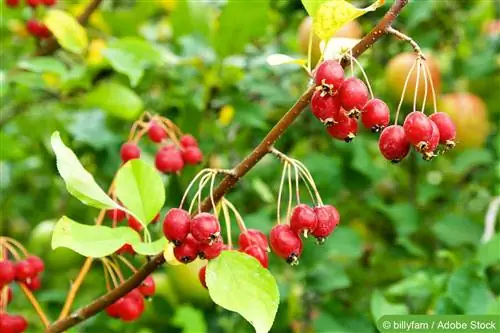- Author admin [email protected].
- Public 2023-12-17 03:39.
- Last modified 2025-01-24 12:45.
The small fruits of the crabapple, which are cherry to plum-sized depending on the variety, take on an intense color as they ripen. Wonderful yellow and red tones delight the viewer and offer a welcome splash of color in the bare, otherwise dreary landscape of late autumn or winter. They serve as welcome winter food for many local birds: blackbirds in particular enjoy the tart apples.
Origin and botanical classification
Like the cultivated or garden apple (Malus domestica) with its countless varieties and edible fruits, the crabapple also belongs to the apple genus (Malus) and as such to the rose family (Rosaceae). Strictly speaking, however, this is not a single species, but rather a group comprising around 500 different species that have one special feature in common: their fruits are only between one and four centimeters in diameter. Growth form and size, foliage, flower and fruit color can vary greatly. As with the cultivated apple, the ancestors of the numerous crabapple species and varieties come from Asia, primarily from China and Japan. Only around 30 species and their varieties are cultivated in Central European gardens.
Crabapple: poisonous or edible?
Contrary to popular belief, crabapples are not poisonous, but are actually edible, despite their impressive beauty - which in nature is often accompanied by toxicity. However, you should not expect a taste similar to the sweeter cultivated apple, because the small fruits of the crabapple are often very tart and therefore not suitable for consumption fresh from the tree. Instead, they can be used wonderfully for fruit liqueurs, jams and jams or as a cake and tart topping.
There are big differences in taste between the individual species and varieties, and birds don't eat every crabapple either: some are too bitter even for blackbirds. However, when it comes to he althy ingredients, the small ones are in no way inferior to their larger relatives: crabapples are also rich in vitamins and minerals and even contain pectin, which is beneficial for digestion.
Appearance and growth
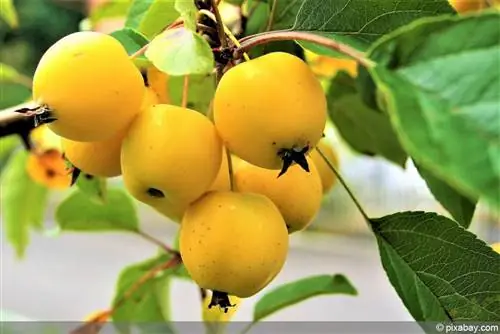
In May, he althy crabapple trees display a lush display of white, pink or red flowers. Depending on the species and variety, it is a large shrub or a small tree between one and six meters high. But the ornamental apples, which naturally grow in a bush shape, can also be trained into a half or standard trunk by cutting. As they age, many crabapples develop a sprawling, gnarled crown, giving them a fascinatingly rustic appearance. In many cases, the mostly yellow, red or striped fruits do not look very apple-like, but are more reminiscent of mirabelle plums or cherries in shape and color. However, their flesh is very firm and the apples - if you leave them - sometimes stay on the tree until the end of winter.
The most beautiful crabapple species and varieties for the garden
The crabapple group is extremely diverse, although only a few are suitable for the home garden. The following four species in particular are often planted.
Japanese crabapple (Malus floribunda)
This popular species is also available as the 'multi-flowered crabapple' and delights in spring with its extremely lush sea of pink flowers. The tree can grow between four and ten meters high and develops a very wide crown with age. In autumn, the orange foliage and red fruits set wonderful accents.
Plum-leaved apple (Malus prunifolia)
This is a rather rare species that delights with pretty white flowers in spring and yellow-green to red, relatively large fruits in autumn. This crabapple usually grows as a shrub with a height of between five and seven meters and an average width of between four and five meters. The dull green foliage turns golden yellow in autumn.
Tea apple (Malus hupehensis)
This beautiful wild species originally comes from China, but is also gaining more and more fans here. The tree, which is up to eight meters high, develops a sprawling crown that is up to four meters wide. The white flowers appear between April and May, and the red, one to two centimeter large fruits are ideal for making jelly or jam. The leaves are traditionally used for tea in China, hence the German name.
Small-fruited crabapple (Malus sargentii)
The attractive shrub, up to four meters high and wide, is ideal for planting as a hedge. The white, sometimes slightly pink flowers appear at the beginning of May, from which only pea-sized, red crabapples develop by autumn. The shrub, which turns bright yellow in autumn, is considered frost hardy and therefore thrives very well even in problematic locations.
The best varieties for the garden and containers
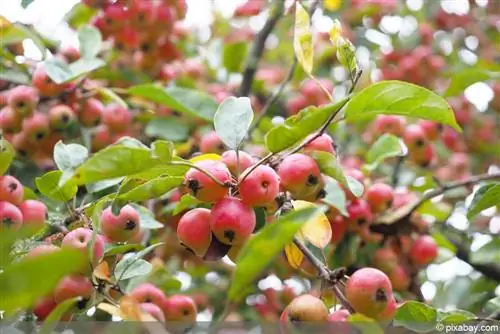
The following crabapple varieties are mostly hybrids, i.e. mixtures of different species. A vegetative propagation method ensures varietal purity, whereby cuttings are usually taken and rooted for ornamental apples. Many tree nurseries graft the slow-growing trees onto faster-growing rootstocks.
‘Butterball’
The fruits of this variety are reminiscent of mirabelle plums in shape and color. They are bright yellow and reddish on the sunny side. The apples grow up to four centimeters in size and taste slightly tart and fruity. They are very suitable for preserving, for example jam, but also for snacking fresh from the tree. The tree, up to six meters high, is considered insensitive to apple scab and mildew.
‘Coccinella’
This relatively new variety not only impresses with its bright red flowers and fruits, the foliage is also reddish in color. In autumn, the tree, up to six meters high, shows a wonderful orange-red autumn color. The variety is considered highly resistant to fire blight and apple scab, and powdery mildew also occurs only very rarely.
‘Dark Rosaleen’
In May, this variety produces very pretty, semi-double, white flowers with a touch of pink. These develop into spherical, dark red fruits. The shiny, green foliage turns orange-red in autumn and, together with the bright red fruits, offers a high decorative value.
‘Evereste’
The vigorously growing shrub can be up to six meters high and five meters wide. Tree nurseries often also offer the variety as a standard tree. In May, the crabapple is covered with numerous white flowers, from which bright orange-red colored fruits develop. The dark green foliage turns bright yellow in autumn. The variety is considered to be extremely flowering and resistant to diseases.
‘Golden Hornet’
'Golden Hornet' is a proven, he althy crabapple variety with white flowers and golden yellow fruits. The tree or large shrub can grow up to six meters high and just as wide. Unless you harvest them beforehand, the apples stay on the tree for a very long time during the winter. In addition, the fruits not only have a high decorative value, they are also very suitable for preserving orfor snacking fresh from the tree.
‘John Downie’
Between May and June, 'John Downie' delights with numerous white flowers up to five centimeters in size. By autumn, these develop into red-cheeked apples up to three centimeters in size, which are ideal for making jams and jellies. The upright growing tree can be between six and eight meters high and up to six meters wide. The dark green foliage turns yellow in autumn.
‘Liset’
'Liset' is a crabapple variety with a high decorative value: the dark green leaves shine bronze when they sprout. The bright purple-red flowers develop into fruits about the size of a pea that are also brightly red in color. The tree grows up to six meters high.
‘Red Jade’
This crabapple tree, which grows up to five meters high and four meters wide, develops a distinctive umbrella-shaped crown over the years thanks to its slightly drooping branches. The large, white flowers appear between May and June and have a high ornamental value. The bright red fruits, which are about one to one and a half centimeters in size, are ideal for compotes, jellies or for eating raw.
‘Red Sentinel’
The rich red fruits of this crabapple variety are also considered delicate and can be eaten both processed and raw. The apples are somewhat reminiscent of cherries in appearance and color. The rather weakly growing tree itself grows up to five meters high and around three meters wide.
‘Tina’
This is a weakly growing and small form of Malus sargentii. The dwarf tree grows to a maximum height of two meters and about the same width. The red fruits, which are just the size of a pea, look very distinctive in combination with the golden yellow autumn leaves. The variety is considered very adaptable, he althy and frost hardy.
‘Wintergold’
This very richly flowering crabapple develops comparatively large apples with a golden yellow color until autumn. These are very popular with birds and other wildlife. The overhanging shrub or tree can grow up to six meters high and four meters wide. The dark green foliage also turns golden yellow in autumn.
Care for crabapples properly
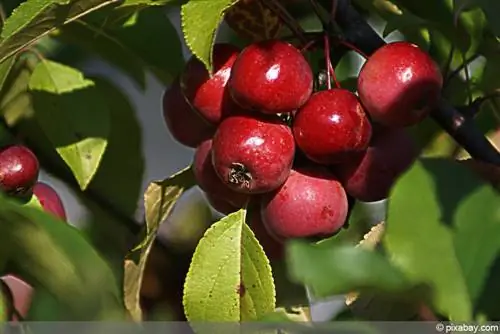
Gardeners also call the crabapple a “multi-season tree” because it has a high decorative value throughout the year. In spring the tree delights with rich flowers, in summer with the light to dark green or even reddish foliage, depending on the species and variety, in autumn with the often bright autumn colors and the no less strikingly colored fruits, which usually last well into winter stick to the tree. Care for the crabapple is uncomplicated, but can vary depending on the variety.
Location and soil
For example, not all crabapple species and varieties tolerate a location in full sun. Many crabapples here tend to fade in color, which is why, if in doubt, a spot in light partial shade is the best choice. Here, most crabapples like the sun in the morning or evening, but the bright midday sun should be avoided. When it comes to soil, most varieties prefer well-drained, nutrient-rich soil.
Tip:
Planting crabapples with spring bloomers
Crabapples are heartroot plants and can therefore be easily planted underneath - onion plants in particular, which include many spring bloomers, are wonderfully suitable for this. A blooming crabapple tree combined with a pretty sea of tulips and other flowers is a beautiful sight.
Smaller crabapple varieties are also suitable for keeping in containers
Many crabapples can grow very tall, reaching heights of between six and eight meters, and they also develop a wide, spreading crown with age. They are still easy to keep in pots, especially when they are young, but should be planted out later. However, varieties that tend to remain small, such as 'Tina', can be cultivated very well in pots. The planters should be about twice as large as the root ball and heavy enough so that they do not tip over along with the tree. Some varieties - especially those from East Asia - are also popular as bonsai.
Watering and fertilizing
Planted crabapples should only be watered when it is dry; in container specimens, no water should remain in the saucer or planter. Do not water on the leaves as this will quickly lead to powdery mildew infestation. If the leaves turn brown in summer and are shed, a lack of water is often the cause. When it comes to fertilization, incorporating ripe compost makes sense; mineral fertilizer should not be used - the plants only need a little nitrogen, otherwise they will develop a lot of unsightly, thin shoots.
Cutting
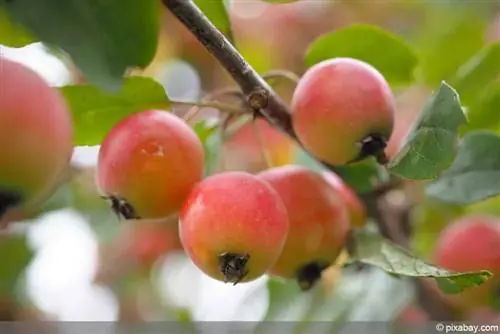
Basically, regular pruning like with cultivated apples is not necessary. The only thing that makes sense is thinning out the crown, as ornamental apples also tend to develop apple scab - and the disease tends to break out when the growth is too dense. The thinning and removal of dead wood takes place in autumn or winter. Younger trees tolerate pruning to achieve a beautiful growth habit. If rejuvenation is necessary, even radical pruning is usually unproblematic. For bushes, you can remove old branches close to the ground.
Wintering
Almost all crabapple species and varieties are hardy and do not require any additional winter protection, at least when they are planted in the garden. This only makes sense for specimens grown in pots, as the roots are more exposed and freeze more quickly. Place the pot on a wooden or Styrofoam base and wrap it with fleece. It is also advisable to set it up in a more protected location - for example in front of a house wall.
Diseases and pests
Crabapples are plagued by the same diseases as their larger relatives. Fungal diseases such as apple scab and powdery mildew are typical, but these can be easily avoided with an airy location and a light crown. Pests such as web moths and their caterpillars can also be found. They mainly eat the buds and young leaves and should be combated promptly - otherwise they will quickly eat the trees bare.
Conclusion
The apple tree is probably one of the most frequently planted fruit trees in Central Europe. Closely related to the cultivated apple is the crabapple, both of which are part of the botanical group Malus and belong to the rose family. In contrast to cultivated apples, crabapples are significantly smaller and the fruits are only the size of a pea to a walnut. There are around 500 different species and varieties that differ significantly from one another in their habits. Crabapples are planted primarily because of their high decorative value, but the fruits are also edible - although not nearly as sweet as traditional apples, but rather tart to bitter. However, you can use them to make jams and jellies; some varieties also taste good fresh from the tree.

